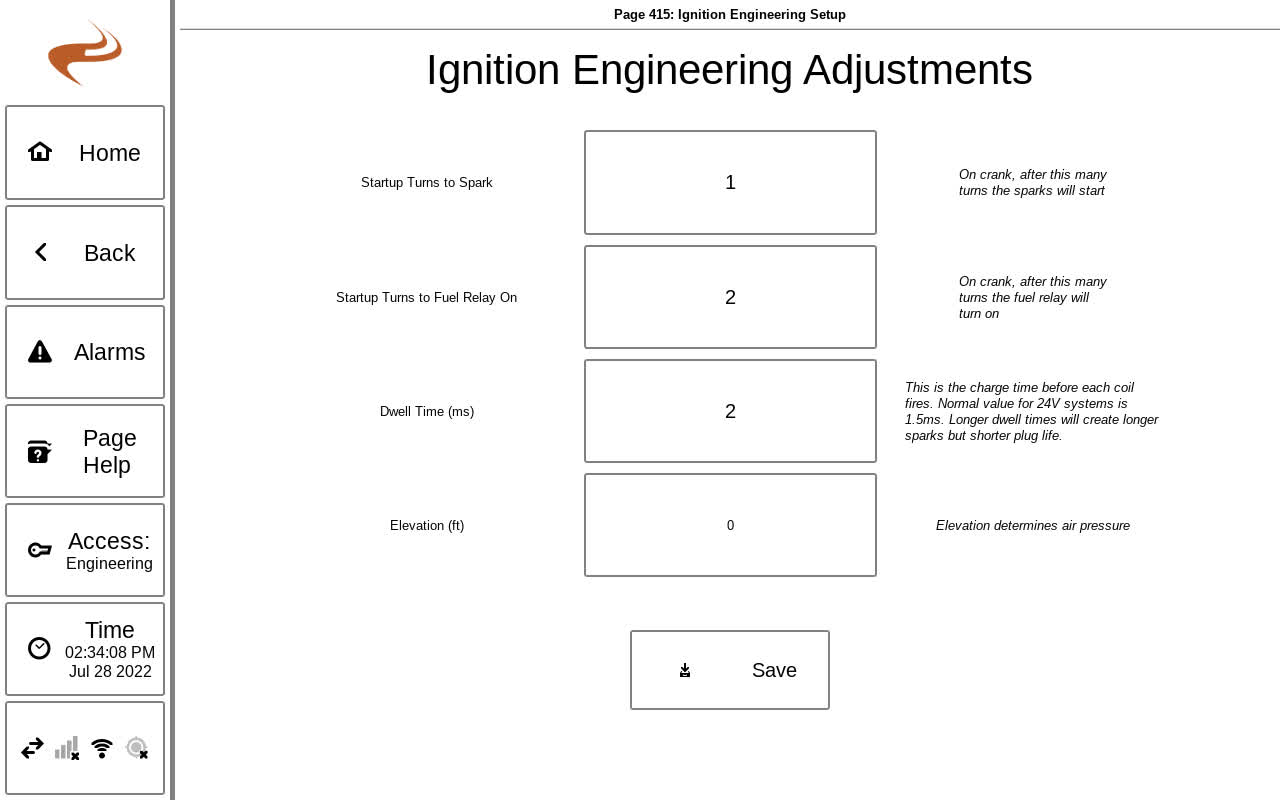Ignition Engineering Adjustments: Difference between revisions
Sean Sanders (talk | contribs) (Created page with "The Engineering Setup screen (Pg. 408) allows adjustments to dwell time, coil startup time, fuel startup time, elevation, and specific gravity. <nowiki>*</nowiki>Insert Image* ''Ignition Engineering Adjustments Screen'' === DWELL TIME ADJUSTMENT === Dwell time is the period of time the ignition coil is charged prior to firing the spark. Dwell times have a direct effect on spark energy and component life. Longer dwell times can provide additional energy to the spark r...") |
Sean Sanders (talk | contribs) No edit summary |
||
| Line 1: | Line 1: | ||
The Engineering Setup screen (Pg. 408) allows adjustments to dwell time, coil startup time, fuel startup time, elevation, and specific gravity. | The Engineering Setup screen (Pg. 408) allows adjustments to dwell time, coil startup time, fuel startup time, elevation, and specific gravity. | ||
[[File:Ignition Engineering Adjustments.jpg]] | |||
''Ignition Engineering Adjustments Screen'' | ''Ignition Engineering Adjustments Screen'' | ||
Revision as of 20:50, 28 July 2022
The Engineering Setup screen (Pg. 408) allows adjustments to dwell time, coil startup time, fuel startup time, elevation, and specific gravity.
Ignition Engineering Adjustments Screen
DWELL TIME ADJUSTMENT
Dwell time is the period of time the ignition coil is charged prior to firing the spark.
Dwell times have a direct effect on spark energy and component life. Longer dwell times can provide additional energy to the spark resulting in hotter and longer spark. If the dwell time is excessive, the ignition coil and the spark plug will have a significantly reduced life span. Low dwell times will extend component life but will result in a lower-energy spark.
Primary current and spark durations should be monitored when adjusting dwell time. It is recommended that dwell time does not exceed 2.5ms for a 24V battery system and 6.0ms for a 12V battery system.
Turbo-charged engines and engines with poor quality fuels may require higher dwell times.
Due to dwell time being adjustable, ignition coils damaged due to excessive dwell times are not warrantied.
IGNITION START ADJUSTMENT
The ignition start adjustment setting sets the number of crank revolutions before enabling the ignition. Additional crank revolutions may be necessary to purge the cylinders of fuel when running in wasted spark mode. On slow-cranking engines it may be desirable to increase this value a few turns so that the ignition timing is more accurately resolved by the time the coils are enabled.
By default, the ignition is configured to start sparking after two flywheel rotations.
FUEL RELAY ADJUSTMENT- ICM1 ONLY
The fuel relay adjustment setting sets the number of crank revolutions before toggling the fuel relay. This setting can be used to turn on fuel before or after ignition coils have been started.
Generally the fuel solenoid should be started later than the coils so that the cylinders are not overly saturated with fuel when the first sparks occur
A fuel solenoid is optional but recommended if starting in wasted spark.
By default, the fuel relay is configured to engage after two flywheel rotations.
The fuel relay can also be used as a run status if desired, it will always be on while the ignition is firing.
UNIT ELEVATION AND FUEL SPECIFIC GRAVITY
If using a prebuilt timing map, the unit elevation and fuel specific gravity can be entered, if known, to adjust the timing map for those conditions.
If using a custom RPM/Load advance, the elevation and specific gravity setting will have no effect.
